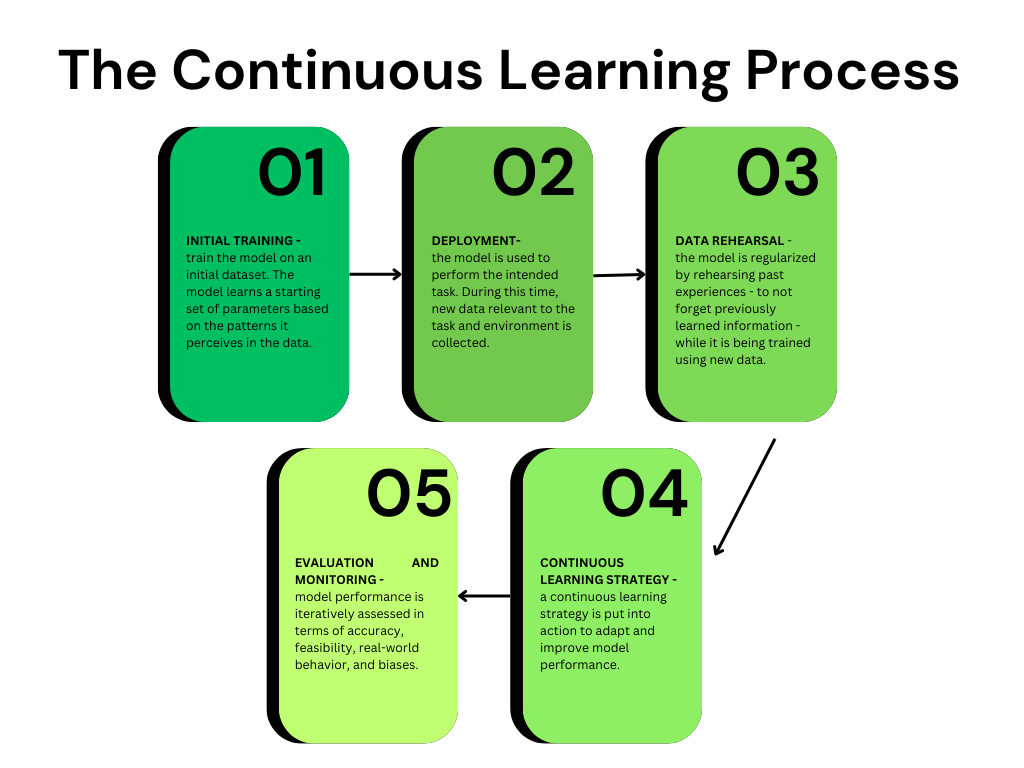This tutorial is a valued contribution from our community and has been edited for clarity and accuracy by DataCamp.
Interested in sharing your own expertise? We’d love to hear from you! Feel free to submit your articles or ideas through our Community Contribution Form.
Machine learning has had a great deal of success in modeling both simple and complex data accurately. Opportunities arising from machine learning exist everywhere, but the fixed nature of most approaches in action is a slowing factor in the adoption of AI. That’s where continuous learning comes in.
Continuous learning is a machine learning approach that enables models to integrate new data without explicit retraining. It builds upon traditional machine learning fundamentals in a way that addresses the dynamic essence of real-world data, creating adaptable models that can improve machine performance over time.
What is Continuous Learning?
Continuous learning, also known as continuous machine learning (CML), is a process in which a model learns from new data streams without being re-trained.
Contrary to traditional approaches, where models are trained on a static dataset, deployed, and periodically re-trained, continuous learning models iteratively update their parameters to reflect new distributions in the data.
In the latter process, the model improves itself by learning from the latest iteration and updating its knowledge as new data becomes available. The continuous learning model life-cycle enables models to remain relevant over time due to their inherently dynamic quality.
Types of continuous machine learning
There are multiple continuous machine learning approaches to modeling. Popular strategies include incremental learning, transfer learning, and lifelong learning.
Other examples are experience replay methods and regularization techniques.
Like with all things data, the choice of approach is not black and white. Instead, it depends on the data, model architecture, desired performance, task complexity, and computational resources available. Oftentimes, a combination of approaches is implemented to enhance learning capabilities.
The Continuous Learning Process
Continuous learning is an evolution of traditional machine learning modeling. Therefore, it involves many of the same modeling principles: pre-processing, model selection, hyperparameter tuning, training, deployment, and monitoring.
Two additional steps are required in the continuous learning process: data rehearsal and the implementation of a continuous learning strategy. These steps serve to ensure that the model is learning from streams of new data efficiently based on the application and context of the data task.

Figure 1: Flowchart of the Continuous Learning Process to Machine Learning
Advantages of Continuous Learning
Continuous learning can be useful for all types of data projects: descriptive, diagnostic, predictive, and prescriptive. It is particularly important in cases involving fast-changing data. Benefits compared to a traditional machine learning approach include:
- Generalization. Continuous learning empowers the model to be more robust and accurate in the face of new data.
- Retention of information. By employing a continuous learning strategy, the model considers previous knowledge gained in past iterations, enabling it to accumulate information over time.
- Adaptability. A model employing continuous learning adapts to new knowledge – such as concept drift and new trends – thereby having greater predictive capabilities in the long run.
Limitations of Continuous Learning
A continuous learning approach does not come without limitations. These should be considered prior to opting for an approach of this kind based on the nature and the expected outcome of the task at hand.
From an operational viewpoint, a challenge is:
- Cost. Continuous learning approaches, while effective, also tend to be more computationally complex than traditional ones as the model needs to consistently adapt to new data. Said complexity often translates into higher economic costs because it necessitates more data, human, and computing resources.
From a modeling perspective, some drawbacks are:
- Model management. Every time a model’s parameters update based on new data, a new model is formed. Therefore, a continuous learning approach may generate a large number of models, complicating the identification of best-performing ones.
- Data drift. For a continuous learning approach to be worthwhile, we must process a large volume of new data. However, such a model risks the chance of losing predictive capabilities if the feature distribution changes abruptly. Learn more about data drift in a separate article.
While cost is not a limitation easy to circumvent, challenges related to modeling can be alleviated by having a proper methodology in place and through human intervention. Practices such as model versioning, monitoring, and evaluation are key to tracking model performance. In addition, human intervention is important to enforce the practices mentioned above and to make contingent choices about the data, such as the frequency and size of updates.
Applications of Continuous Learning
Given the additional cost and complexity arising from continuous learning, this approach is best suited for applications involving an ongoing stream of new data. This entails that the environment of the data task must be constantly evolving.
Current applications of continuous learning include:
- Computer vision. The dynamic nature of image-driven data makes continuous learning approaches popular for training algorithms to identify and classify visual information. These are frequently applied in facial recognition and imaging technology.
- Cybersecurity. Continuous learning approaches are implemented to ensure constant monitoring in IT security infrastructures. They are key in detecting phishing, network intrusion, and spam, among other security-related operations.
- Healthcare. Due to the evolving essence of diseases, continuous learning approaches are used in various healthcare fields to enhance diagnostic workflows around disease diagnosis. Specializations such as oncology and radiology have been early movers in exploring continuous learning AI to this end.
- Robotics. Continuous learning has been utilized to enhance the adaptability and performance of robots in different environments, enabling them to optimize their actions in changing conditions based on past and new experiences.
The Future of Continuous Learning
The advent of digitization due to technological advancements, unprecedented data generation, and socioeconomic mindset shifts means that continuous learning will become more widely adopted in the future. This is because the algorithms used to model different applications will need to be adaptable enough to meet the growing flow of data in every area of life, every day.
From current applications like computer vision to possible ones like smart city management, continuous learning has the potential to revolutionize the outcomes we can expect from artificial intelligence, elevating machine intelligence to new levels.
To effectively implement continuous learning strategies, it’s crucial to overcome inherent challenges like computational costs, model management complexities, and risks associated with data drift. For those who are keen on mastering the art of developing and managing machine learning models effectively for production and wish to gain insights on how to continuously improve them over time, don’t miss the opportunity to enroll in DataCamp’s Developing Machine Learning Models for Production with an MLOps Mindset Course. This course will equip you with the knowledge and skills needed to design machine learning models that are production-ready and adaptable to evolving data landscapes.
Continuous Learning FAQs
How does Continuous Learning differ from traditional machine learning?
Unlike traditional machine learning models, which are trained on a static dataset and require periodic retraining, continuous learning models iteratively update their parameters to reflect new distributions in the data, allowing them to remain relevant and adapt to the dynamic nature of real-world data.
What are the types of Continuous Learning approaches?
Popular continuous learning approaches include incremental learning, transfer learning, and lifelong learning. Other strategies involve experience replay methods and regularization techniques.
Why is Continuous Learning important?
Continuous Learning is crucial in scenarios involving fast-changing data. It enables models to be more robust and accurate in the face of new data, retain information from past iterations, and adapt to new trends and concept drift, enhancing their predictive capabilities in the long run.

